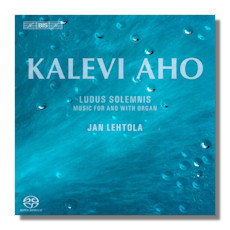
The Internet's Premier Classical Music Source
Related Links
- Aho Reviews
- Latest Reviews
- More Reviews
-
By Composer
-
Collections
DVD & Blu-ray
Books
Concert Reviews
Articles/Interviews
Software
Audio
Search Amazon
Recommended Links
Site News
 CD Review
CD Review
Kalevi Aho

Music for and with Organ
- Quasi una fantasia for Horn & Organ (2011) 1,2
- Epilogue for Trombone & Organ (1998) 1,5
- Contrapunctus XIV from J.S. Bach's "Die Kunst der Fuge" (2011) 1
- Häämarssi I (Wedding March I - 1973) 1
- Häämarssi II (Wedding March II - 1976) 1
- Hääsoitto (Wedding Music - 1999) 1
- Ludus solemnis (1978) 1
- In memoriam (1980) 1
- Laulu maasta (Song of the Earth) for Violin, Oboe & Organ (2002) 1,3,4
1 Jan Lehtola, organ
2 Petri Komulainen, horn
3 Anna-Kaisa Pippuri, oboe
4 Kaija Saarikettu, violin
5 Jussi Vuorinen, trombone
BIS SACD-1966
Born in 1949 in Finland, Kalevi Aho studied with Rautavaara (at the Sibelius Academy) and with Boris Blacher in Berlin. His œuvre is extensive (five operas, 15 symphonies, 20 concerti and much other chamber and orchestral music). Yet he is not so well known as he deserves to be. But a few bars of the imaginative and original music on this CD from the ever-enterprising BIS label ought to convince most listeners that Aho is a vibrant force with a great deal to communicate to us.
Other than Messiaen, the past century hasn't seen major contemporary composers writing for the organ. This CD has nine such pieces; in the more substantial ones, Aho has produced compelling music using such unlikely accompanying instruments as the violin, oboe, horn and trombone. But there is not a hint of mere novelty, spurious combinations for shock; still less of an attempt to build hybrid forms or formats.
This is music of great eloquence and perception. For sure, the individual characteristics of the instruments are not overlooked… the breathiness of the winds and brass; the ability of the horn potentially to drown out even the organ with volume and projection; the mellowness of the violin and oboe. But there is a wholeness and roundness in Aho's writing that produces music of real melodic and harmonic interest as well as provoking an awareness of the textures.
By choosing the task of writing a completion of the 14th and final Contrapunctus from Bach's "Die Kunst der Fuge" [tr.3], Aho anchors his work for organ firmly in a recognizable tradition. The three short Wedding Marches [tr.s 4, 5, 6], for instance, have an accepted precedence – as wedding music tends to do. Those, in fact, were written specifically for family or friends. Similarly, Ludus solemnis [tr.7] was for the inauguration of a church in Aho's home town. As In Memoriam [tr.8] was for the funeral of author, Juha Mannerkorpi; and Laulu maasta [tr.9] for Aho's own father's funeral. Then Epilogue [tr.2] took up a suggestion of trombonist Christian Lindberg's while preparing and playing Aho's Ninth Symphony, which features that instrument too.
But this is not "occasional" music, or music designed merely to meet a "local" (and/or passing) circumstance or commission. For all that this CD has gathered Aho's work so far for the organ in several guises, the music has great depth and breadth and stands as worthy of close attention in its own right. Jan Lehtola plays with insight, conviction and a true understanding of Aho's achievements and intentions. Technically very adept, Lehtola is determined to forge a place for the organ in contemporary music. If these commanding yet sensitive performances are anything to go by, he's on the right track.
He reveals and tends the music as for itself, without need for advocacy. It also helps that the three Scandinavian organs used in this set of pieces (St Paul's Church main organ, Helsinki; Porthan organ Kotka Church; Åkerman and Lund, St. Johannes Malmö) are as fine as they are. The playing of the four other instrumentalists is equally focused and full of energy, grace and insight. What's more, these soloists' ability to blend the often quite contrasting timbres and palettes into a whole that respects both sum and parts, is one of the strong points of this collection.
While none of the music contained in this collection could be considered revolutionary, it's very satisfying; it is different, each piece from the last, and draws you in to anticipating what comes next. And never being disappointed. Aho's organ music is sufficiently well-conceived to require close listening – particularly since it's neither chamber, solo nor symphonic in tone. Yet it all has a field of vision (thanks to the organ) which is both extensive and dynamic. At the same time the qualities of dignity and suggestion are balanced in each piece; and thoroughly understood by the performers, who never feel they have anything to prove.
The three acoustics do justice to the various combinations of instrument and/or the organ alone. The booklet that comes with the CD sets the scene for this area of Aho's work and supplies a brief description of each piece as well. If you're new to Aho, this CD won't provide an entirely representative sampling of his world. Only the first and second wedding marches are already available. But it will suggest avenues well worth pursuing. Both for the standard of musicianship and the variety of inspiration that Aho has in this area, if not for music that's aggressively experimental, this is a CD to consider seriously.
Copyright © 2014, Mark Sealey


















